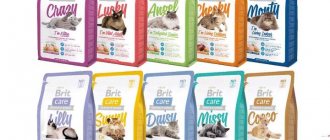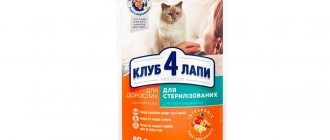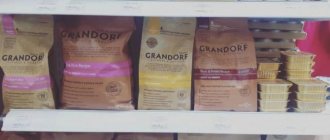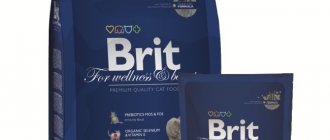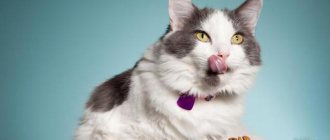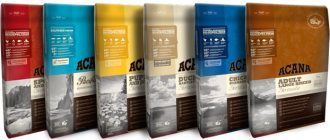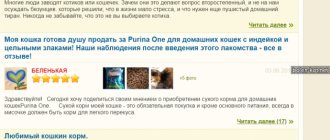Previously, the PetObzor website published a rating of cat food, which turned out to be very useful for many people and collected a lot of reviews. But that rating concerned only dry food, and in the comments there were numerous requests to tell which wet cat food is better than all others.
In this article we will present our rating of wet food, justify it by comparing ingredients and reviews, and also tell you how you can choose a good wet food for cats yourself.
The main rules for feeding kittens with wet ready-made diets
Kittens can be given wet food from 3–4 weeks, when babies begin to be switched to “adult” foods, but it is better to wait until 5–6 weeks. If you do this ahead of time, you can cause indigestion and dehydration in the animal. In some cases, pets develop pancreatitis due to premature cessation of breastfeeding. Often kittens simply refuse to eat. At an older age, wet food can be given, but it is better to decide on the animal’s future diet as early as possible so that the gastrointestinal tract adapts faster.
Wet complete foods are not suitable for systematic feeding, even if they contain all the necessary vitamins and minerals. When converting to pates and jellies, the owner should take this into account. Wet food can be used as a treat, a supplement to the main diet of natural products, or an intermediate step before switching to dry kibble.
Due to its specific consistency, wet food can be prescribed to a kitten by a veterinarian for gastrointestinal disorders, acute diseases of internal organs and in the postoperative period
The need to combine different types of food is related to the consistency of the food. Pates and pieces in jelly contain too much moisture. In addition, during their production, meat is ground, which leads to the destruction of natural fibers. It is more difficult for kittens to absorb nutrients from such food. The gastrointestinal tract gets used to the reduced load and stops working at full capacity. However, this is not the main problem.
Soft food does not contribute to the natural cleansing of the walls of the gastrointestinal tract and anal glands - small sacs with odorous secretions that allow animals to leave marks when defecating. With prolonged consumption of softened foods, rotting particles settle on the intestinal mucous membranes, which release toxins into the blood. As a result, the animal may develop symptoms such as lacrimation, itching, hair loss, etc. When my friend’s cat’s condition sharply worsened, she suspected an allergy. Several veterinarians could not determine the cause of the illness and only advised trying to change the food. Ultimately, she turned to a forum for help, where she was advised to gradually transition the animal to pelleted diets or natural food. This helped, although during the adaptation for another 2-3 months the cat was sometimes bothered by digestive disorders.
Inflammation of the paraanal glands can be diagnosed after a visual examination.
In the case of the paraanal glands, the situation is even worse. If excess secretion is not removed by mechanical action during defecation, the liquid accumulates in the sacs. Later, blockage occurs, due to which the glands are not cleared even with normal stool consistency. The sacs become enlarged and inflamed. They cause discomfort to the pet, which is why he may try to ride on his butt on rough surfaces, pay too much attention to the anus area, and even try to chew out swollen glands. If left untreated, tissue infection occurs and purulent exudate forms. In severe cases, death may occur.
To prevent inflammation of the paraanal glands, it is important to include coarse fibers in the diet to cleanse the gastrointestinal tract and normalize the consistency of stool. Your pet's menu should include meat. 10% of the total volume can be occupied by vegetables and dairy products. Another alternative is dry food.
Wet food should not be mixed with other types of food at the same feeding. If the kitten refuses to eat natural foods without pates and jellies, you can add a little pouch sauce to the main dish, but leave the hard pieces for next time. Up to 3 months, babies are given food 5-6 times a day, later the number of feedings is reduced to 4. After 4 months, the kitten can be offered food 3 times a day. By the age of six months, depending on the size and preferences of the pet, the pet is fed 2-3 times a day.
Wet food should not be left freely available like dry food. It provides an excellent environment for the development and reproduction of bacteria. Once placed in a bowl, the product remains usable for only 1–2 hours, so kittens are fed frequently, but little by little. The daily intake depends on the calorie content of the product and the body structure of the animal and is selected individually based on the manufacturer’s recommendations.
Ceramic bowls are more reliable than plastic ones because they do not react with microelements contained in food
The maximum shelf life of opened packaging is 1 day. To prevent bacteria from contaminating food, food is placed in sealed glass containers. The use of plastic utensils is allowed. You cannot leave food in metal cans, as this will lead to oxidation and premature spoilage. In the case of spiders, you can simply fasten the edges of the package with paper clips, but this does not guarantee maximum safety of the product. It is strictly forbidden to give spoiled food to kittens: due to the delicate gastrointestinal tract, this can cause indigestion, diarrhea, dehydration and rapid death.
Since bacteria multiply better in wet food, it is important to keep the dishes clean. Bowls must be washed after every meal. It makes more sense to use metal or ceramic containers. Plastic ones scratch faster. Due to the impossibility of high-quality cleaning, food particles accumulate in microscopic cracks and bacteria develop. It is recommended to change bowls regularly. The frequency depends on the material. For example, it is recommended to use plastic containers for no more than 1–2 months.
To assess a cat's physique, you need to look at it from the side and above, and also try to feel the hips
When feeding wet food, it is important to monitor the body structure of the animal. It is recommended to weigh your pet regularly in order to notice weight gain in time. You can rely on the tables of the corresponding breed, but due to individual characteristics, the normal weight for a particular cat may differ. It is advisable to evaluate your physique by appearance. The pet's ribs should be felt with moderate effort. The bones on the hips and chest ideally protrude slightly, giving definition, but do not stick out. A barrel-shaped figure, bulging sides and a drooping belly indicate weight problems.
Customer reviews about Gourmet cat food
Maxim : “I am a veterinarian by training. I worked in this field for many years. Unfortunately, I will not recommend Gourmet for regular nutrition. Moreover, in its composition it is more like economy class food than premium food. It contains catastrophically little meat, is poorly fortified, and contains strange additives. There is no clear description of the ingredients. It is quite suitable as a treat, but should be given rarely. The most successful product is canned fish. In any case, wet food is much healthier than dry food - the risk of kidney damage to a cat is reduced several times.”
Anna : “I have a cat at home. Quite a picky person, I tell you. I give wet food 1-2 times a day. I buy Gourmet. My cat shakes when she eats it. The canned food actually smells very nice and the consistency seems normal in appearance. I like Gourmet because the food comes in small packages, just for one feeding. Nothing spoils and nothing needs to be thrown away. I always buy different lines. My cat and I really like it, so I have no hesitation in recommending it to you too.”
Victoria : “I feed my pets only homemade food and sometimes holistic food. But somehow the store didn’t have the food I needed, so I bought Gourmet. The price is very good, only 30 rubles. I took Gourmet Gold. My cats liked it and immediately started gobbling it up. I was somewhat alarmed that the new food went so well. I read the ingredients and saw the presence of preservatives. I think that's the point. Now I don’t even know what to do. I think I’ll occasionally buy Gourmet to diversify the menu.”
How to choose the best food for a kitten
First of all, kitten food should be complete. This means that it contains all the necessary vitamins, amino acids and minerals: tocopherol, unsaturated fatty acids omega-3 and omega-6, taurine, methionine, etc. Ideally, they should be presented in their natural form, i.e. as meat, vegetables, fruits and herbal supplements, however, in the production of wet food many ingredients cannot be used. As a result, it is necessary to introduce vitamin-mineral complexes into the composition. If there is a deficiency of nutrients, the kitten may have problems at the stage of development of the musculoskeletal system and the formation of immunity. There is a risk of pathologies of internal organs.
Rickets and deformation of the limbs are the result of a lack of calcium in the menu
It is strongly recommended to avoid feeds that contain dyes, thickeners and sugars. They help give the product a pleasant consistency and color, but for cats these parameters have no meaning. Supplements can be dangerous for pets, especially when they are young. Some dyes can cause irritation to the internal lining of the gastrointestinal tract and urinary system. This leads to blood flow, inflammation and poor digestion.
Manufacturers are forced to add preservatives to keep the food fresh as long as possible. Vitamin E (tocopherol) can act as an antioxidant, but it alone is not enough for reliable preservation. The absence of preservatives in the ingredient list is a warning sign. This may indicate that the manufacturer is trying to hide some information about the composition from the buyer. It is recommended to give preference to wet food whose list of ingredients specifies the type of preservatives. The substance must be safe.
Canned mango pieces are visible to the naked eye; the fruit is used to enrich feed with vitamins and fiber
The presence of grains in wet food is not allowed. They are practically not absorbed by the cat’s body and are used as an inexpensive filler that allows you to save money. A good quality wet food may contain small amounts of vegetables, fruits or beans. They are necessary to improve digestion and normal removal of hair from the gastrointestinal tract. Such ingredients should not be placed above the meat components.
Meat is the basis of the diet of predators. Ideally, animal products are high on the ingredient list. This can be one variety or several, as well as offal. Most often, the composition includes the liver, kidneys, lungs and hearts. These are good sources of cartilage, proteins and vitamins. It is welcome to indicate the specific type of offal and type of meat. It is advisable to avoid feed that contains such generic names as “poultry”, “chicken”, “fish”, etc.
It is advisable to prefer products that contain animal fats. They are better absorbed by cats. Pets also need vegetable oils, because the balance of unsaturated fatty acids in them is different, but their proportion should be lower. The most valuable ingredients for cats are turkey fat and salmon oil.
Denser wet foods prevent indigestion when switching to solid natural foods and dry diets
The choice of consistency depends on the kitten’s preferences. In some cases it is wise to use pate. This applies to animals with difficulty digesting and small kittens (3-5 weeks). Unless you have special needs, it is recommended to choose fibrous pieces that are closest in texture to meat.
Manufacturer
is IP Nikitina P.A.
Natural food for dogs and cats - this is how the brand owner positions his activities. The official website states that the production process is based on an innovative (and therefore unique) technology for preparing food for animals using modern equipment and storage in retort bags - new generation eco-packaging.
All components used are packaged, sealed and put into processing just like that. The food is sterilized and retains both taste and aroma. No water is used during cooking, i.e. Everything is cooked in its own juice, without thickeners or other ballast substances.
Classes of prepared feeds
When choosing ready-made wet food, you first need to pay attention to the product class. In some cases, it is reasonable to immediately abandon the purchase.
Economy
Economy class has aggressive advertising, but almost zero nutritional value. Most representatives contain sugars, dyes and potentially dangerous preservatives. Often the proportion of fat is lower than stated, which can cause disorders of the nervous system and weakness in kittens. Such foods most often contain more grains and water than meat, so their presence on the menu is impractical. Economy class recipes do not meet the natural needs of pets.
Economy class food is easy to recognize: most brands can be seen on TV screens and on the shelves of hypermarkets
Systematic feeding of low-quality feed is fraught with many problems. After eating such foods, kittens often refuse other food. I don’t know what manufacturers add to wet food, but I personally had the opportunity to wean my pet off Whiskas and Friskies diets. I gave them to my kitten unknowingly until I visited the veterinarian for preventive vaccination. My pet starved for 3 days, but did not approach the food bowl until he realized that I would not give him any other food. This is despite the fact that I did not switch it abruptly, but mixed different foods. Judging by other people's reviews, I was lucky. Many people experience problems with the bladder, kidneys and pancreas after eating economy food.
Premium
Premium class, despite the name, is little better than budget food. It differs from the latter in its increased meat content: on average 10–20% versus 4%. Considering that in most cases, not fillets are used, but whole carcasses or, even worse, mixtures of unclaimed offal, the share of high-quality proteins is actually lower. Many premium kitten foods contain grains. Sometimes there are exceptions, but then other products act as filler.
Royal Canin is a classic representative of the premium class and, despite the assurances of the manufacturer and representatives, this food should not be given to a kitten
Premium class is conditionally suitable for feeding kittens, but these diets are best avoided. A friend of mine gave her kitten Royal Canin spiders. This is a well-known brand that is famous for its healing diets, so many people trust it. At first everything was fine, but closer to the year the cat was diagnosed with urolithiasis. And this is far from the only problem that animal owners may face. Most often, pets develop allergies to bird protein and grains.
Super premium
Super-premium wet food consists primarily of high-quality meat products. Cereal additives are extremely rare in them, but if they are present, the manufacturer will certainly indicate the type of grain. Companies often specify the percentage of components. Manufacturers indicate not only the type of meat, but also the type of offal. The ingredients are used either fresh or raw, i.e. they are not subjected to repeated freezing and additional processing. Companies often clarify that they do not add whole carcasses to the feed, but pure meat or fillets.
Bozita is not the most popular brand, but it is one of those that can be recommended for purchase
Super-premium food is the most acceptable option for kittens in terms of price-quality ratio. This is the most budget-friendly food for a pet. Such diets do not cause the development of pathologies and help maintain optimal health of the animal. Only the holistic category is better than this class, but representatives of the latter group are expensive and are not always suitable for pets.
Holistic
Holistic class is the elite among cat foods. Manufacturers do not skimp on ingredients, so the proportion of liquid is relatively low, but sufficient for comfortable consumption (about 80%). The overwhelming majority of the composition is occupied by meat products. Most often there are several of them, which helps provide the animal’s body with various vitamins, minerals and amino acids. Useful substances are presented in their natural form. This increases their digestibility.
There is no special diet for kittens in the Grandorf wet food line, but in the case of holistic cats this is not required: due to its balanced composition, the product is suitable for any healthy animal
Holistic-grade foods often include therapeutic additives, vegetables, herbs, fruits, beans, etc. Often on the lists you can find peas, which improve digestion. Yucca extract is added to slow down the growth of bacteria in the gastrointestinal tract. This helps reduce the smell of feces. A friend of mine, when she transferred her kitten from economy class to holistic, immediately noted this advantage. However, the opposite situation is also possible: kittens that have been fed cheap foods with grains for a long time often experience indigestion when switching to meat diets. It is important to take a small portion to observe the animal’s reaction, and if problems arise, first transfer the pet to the super-premium class.
Rating of the best canned food for cats: from premium to holistic
The quality of the food is determined by its class: economy, premium, super-premium or holistic. Economy food (Whiskas, Vaska, Night Hunter, Kitekat, etc.) are not recommended for feeding indoor and outdoor cats, since they do not contain complete information about the components included in the composition, are poorly balanced in terms of the content of useful and nutritional components, and may also contain antibiocellular psychoactive additives that cause severe dependence in the pet.
Advice! For these reasons, for everyday nutrition you should choose food of at least premium class, and the best option, according to veterinarians and experts, is to feed the animal with super-premium or holistic food.
| Type | Characteristic |
| Premium | Premium canned cat food is one of the most optimal price-quality options for owners on a limited budget. They contain a lot of meat components (more than 40%), additional vitamin and mineral supplements, and for their production not only by-products are used, but also various parts of animal carcasses, which increases the quality of the feed. |
| Super premium | Super-premium food has an almost ideal composition, and only high-quality meat ingredients, grains and vegetables are used for their production. The content of the main component, which is listed first in the composition, in such foods is usually more than 40%, so feeding super-premium canned food is the basis of a healthy life for cats of various breeds. |
| Holistics | This is the most expensive and high-quality category of canned cat food. The main concept in the production of holistic food is preparation “as for humans”. They contain only natural fresh meat, broth or water, mineral supplements, fructo-oligosaccharides (according to these criteria, Applaws super-premium food can also be classified as holistic). In the production of holistic products, the use of flavors, dyes and other synthetic additives is not allowed. |
Popular wet food
For comparison and an honest review, we will include representatives of different categories in the list. This will help you further distinguish quality food from dangerous ones.
Leonardo
Leonardo food is classified as super-premium. The line includes several varieties of ready-made diets for kittens. Two of them are wet food. They differ not only in packaging, but also in composition, so it would be appropriate to consider both compositions.
You can see the company's distinctive logo on Leonardo product packaging
Canned food for kittens Leonardo Finest Selection Kitten based on poultry
Wet food is only available in spider form. One bag weighs 85 g. The average cost is 100–120 rubles, but you can save money if you purchase a large package of 16 bags. Its price is 1200–1300 rubles. Then the average cost of one sachet is reduced to 75–80 rubles.
On the packaging there is an icon in the form of a crossed out spikelet, which indicates the absence of cereals in the composition
The canned food contains the following ingredients:
- poultry meat, heart, liver (70%);
- poultry broth (29.1%);
- fish oil (salmon family) (0.4%);
- minerals (0.5%).
It is commendable that the manufacturer includes fish oil in the composition and does not use thickeners, but I would recommend taking a closer look at other products. The presence of a “bird” in the composition is confusing. It can be either turkey or duck, or chicken. This is important in the case of allergic animals. In addition, such questionable decisions on the part of the manufacturer undermine trust, since the company may include different meat components in different batches. My friend’s kitten developed an allergy after eating Leonardo food. It was only possible to figure out that bird protein as a whole was to blame only six months later.
Canned food for kittens Leonardo Rich in Poultry with poultry flavor
Canned food is produced in metal cans of 200 and 400 g. The cost is 100–120 rubles. and 150–200 rub. respectively. Taking into account the difference in weight, tin cans are more economical than spider cans.
Surprisingly, canned food can be classified as premium in composition rather than super-premium, like spiders
The diet includes the following components:
- meat and meat by-products (65%; of which poultry 40%, beef 25%, meat broth 29.5%);
- eggs and egg products (whole egg 4%);
- minerals (1%);
- vegetable oils and fats (fish oil (salmon family) 0.5%).
The reason for this difference in price immediately becomes obvious: canned food in jars is inferior in composition. The manufacturer uses meat and meat by-products as a base. Even with clarifications, the component is questionable. Most likely, not only whole carcasses are used, but also industrial waste. The proportion of fish oil is greatly reduced. The only advantage is the presence of eggs in the composition. It is a source of easily digestible proteins and vitamins, but cats with poultry allergies may experience worsening of the condition.
Almo Nature
Almo Nature is an Italian super-premium food. The company also produces 2 types of canned food for kittens.
You can recognize Almo Nature products by their characteristic logo
Classic Cuisine Kitten
The food is produced in small (55 g) packets. The cost of one sachet is 90–100 rubles. Unofficially, this recipe is classified as holistic due to its high quality compared to other products in the series.
Almo Nature spiders are a unique variation on the theme of the variety of flavors of wet food, but they are holistic, so the food will not worsen the health of gourmets
The food contains the following components:
- chicken broth (42%);
- chicken (40%);
- rice (8%);
- cheese (3%);
- chicken liver (2%);
- oil (2%);
- dried egg product (2%);
- Choline chloride (0.05%).
The proportion of chicken broth is relatively high. In most feeds it is 25–30%. Another drawback of the product is the presence of rice. Perhaps in this case it is used as a source of plant fiber, but there are more useful analogues. Peas or vegetables, for example. Cheese is a surprising ingredient in cat food. If there is no salt in it, then it is not dangerous and helps the pet get enough fat, like butter. Chicken is better than just poultry, but worse than fillet. Most likely, meat with skin is used. Choline chloride is vitamin B4.
Overall the food is good, but could be better. It was possible to introduce preventive additives into the composition, for example, at least yucca. The presence of eggs and quality sources of animal fats is commendable, but the presence of rice is questionable. It seems that the manufacturer decided to save money by using broth and cereals. And all this against the backdrop of high cost: about 2 rubles. for 1 g. My kitten really likes this food, but I only give it as a treat. I feel good, the chair after Almo Nature is decorated.
Legend Kitten Chicken
Legend Kitten Chicken is a classic canned food for cats. They consist almost entirely of meat and broth. On average, a large jar (140 g) costs 70–100 rubles.
A small kitten may get enough of a large jar, but for teenagers this is too modest a portion.
The canned food contains the following components:
- chicken meat (75%);
- chicken broth (24%);
- rice (1%).
The share of rice is negligible, so it can be ignored. Legend Kitten Chicken is the most common canned chicken. They can only be praised for their meat component, but this is already a significant plus. The buyer can be sure that the cat does not receive low-quality offal, but a full-fledged fillet. However, the food cannot boast of anything more: it does not contain fat or herbal additives that could provide the body with vitamins and minerals or ensure the prevention of urolithiasis, the formation of hairballs, etc. For this reason, I would not buy these canned foods, because I I can cook fillet with broth for the kitten myself. It will be cheaper. Almo Nature food should under no circumstances be used as a complete food: it does not contain all the beneficial substances an animal needs. I personally became convinced of this when my sister’s kitten, despite seemingly good nutrition, began to peel off its skin due to a deficiency of vitamins A and E. With prolonged feeding, the consequences can be worse. Legend Kitten Chicken can be used as a treat against a natural menu in cases where for some reason you cannot prepare food for the kitten yourself.
Applaws
The Applaws line of wet food includes 2 types of canned food for kittens: chicken breast and tuna. They are almost identical in composition to each other, so we will consider the latter diet.
Applaws wet food is another representative of classic canned food: only meat and broth, nothing extra, except maybe gelatin
In the list of components you can see the following items:
- pieces of tuna fillet (40%);
- fish broth;
- vegetable gelatin.
The quality of canned food for kittens is close to the super-premium class and resembles Legend Kitten Chicken, but the manufacturer saves even more on raw materials. At a fairly high price (75 rubles for 70 g), the jar contains only 40% tuna. I am glad that this is high-quality meat, but the cost of the feed is too high. There are no vitamins and minerals in the composition, therefore it cannot be used as a complete product. Vegetable gelatin does not pose a danger to animals, but it also has no nutritional value. Its presence in food is undesirable. Despite the disadvantages, the diet can be a good temporary option for kittens who are prone to allergies. This is one of the few representatives of the super-premium class that does not contain bird protein.
Sheba
Sheba food is alternately classified as either economy or premium. In fact, the quality of the diets falls between these categories. We included the brand in the review to show how cheap food differs from expensive food. There are no special products for kittens in the Sheba series of diets. Theoretically, regular food can be given to babies, but this is not recommended due to its weak composition.
The appearance of the wet food differs from that indicated on the packaging, which allows one to suspect the manufacturer of dubious marketing moves.
For example, consider the list of components of “Sheba” with chicken and turkey. The list of ingredients contains the following items:
- meat and offal (chicken min. 30%, turkey min. 4%);
- taurine;
- vitamins;
- mineral things.
The turkey portion is too small to count. The situation is better with chicken, but super-premium food has 1.5–2 times more meat. In addition, low-quality raw materials are used in production, as indicated by the common names of the ingredients. The share of pure meat is probably lower in the end. The presence of taurine in the composition indirectly indicates a lack of quality sources of animal proteins. The food is complete, but this is achieved through enrichment with additional substances. In fact, there is little useful in the product. The advantages include the absence of grains and low price. Pouches (85 g) cost 30–35 rubles.
Eukanuba
Eukanuba remained confidently at the super-premium level for a long time, but after the transfer of the brand to Mars Corporation, the recipes were changed. Now the food is more likely to belong to the premium category. The company specializes in producing products for dogs, but there is also a line for cats. The series contains diets for kittens.
The Eukanuba brand is one example of expensive but low-quality feed; the markup on products is determined only by the previous reputation and brand
There is only one wet food. It consists of the following components:
- meat and offal (including chicken at least 26%);
- cereals;
- vitamins and minerals;
- amino acid methionine;
- fish fat.
The use of fish oil is commendable, but it may be of poor quality. Grains are an undesirable ingredient. It is in second place, so we can conclude that the manufacturer included it in the composition as a cheap filler. Methionine is found in meat products. Its presence indicates a lack of animal proteins. Meat and offal are in the first position, but their share is small (26%). Common names raise doubts about their quality.
The Eukanuba feed has gone bad. I once gave it to my cats without any problems, but the last time I offered canned food to a foster kitten, he developed an allergy. The symptoms went away only after a week, although the feeding was only once. And this despite the fact that these are expensive canned goods. Standard pouches (85 g) cost 50–60 rubles, which brings their cost closer to super-premium products.
Range
We list the existing “Healthy Pet” lines:
Grain-free natural cat food with beef and vegetables is available in packs of 80 g. There is a separate formula for kittens (pate), for adult cats (pate and pieces), for cats with cranberries (pate and pieces).
Grain-free natural cat food with chicken fillet and turkey (identical to the above in both weight and composition).
Complete natural food for cats is also divided into food with beef, chicken, turkey, and is also available in the form of pate or broth with meat fibers.
Shelf life: 2 years from the date of preparation. The packages can be stored at a temperature not lower than 0 and not higher than +30 degrees, opened - only in the refrigerator and no more than a day.
Feedback from pet owners
I feed my cat Almo Nature, but I focus on canned food, for some reason their quality is much better. All my friends also praise the wet food of this brand. On cans, bags and packaging the composition is clearly stated, but at the office. There are no specifics on the manufacturer’s Russian-language website. They will write about the pulp of vegetables, or about minerals, but there are no details. As a result, high quality ingredients are used, but the composition of the food is modest. From the packaging, sometimes imperfect compositions appear, which should be in a super-premium product, but are quite good in quality. There is little fresh meat, only 15–20%; there is animal fat and yeast, and the rest is additional components: bone meal and offal. But this situation is saved by the fact that there are many varieties of food, so the owner will certainly be able to find something suitable for his animal.
KARATEISTKA
https://otzyvkorm.ru/almo-nature-dlya-koshek/
I’ve been feeding my kitten Leonardo canned food for about 6 months now, I like the rabbit flavor best, sometimes I buy meat + fish, I’m afraid to give chicken because of allergies. No matter how closely I looked at the contents of the jar, I didn’t find anything suspicious, the food smells wonderful, it undoubtedly contains natural meat, and from the heart, there’s almost a heaping amount of it in the jar, and there’s a small amount of jelly. Yes, canned food is greasy, but all the fat settles at the bottom and I just throw it away mercilessly; there’s no point in saving here. An open jar can be stored in the refrigerator for up to 4 days without any problems, but I prefer not to risk it and buy 200 gram jars. The kitten feels great on these canned foods, we will soon switch to drying, and first we will also try Leonardo.
RenaZav
https://otzyvkorm.ru/leonardo-dlya-koshek/
There are simply no downsides to this food. If your budget allows, then buy it. I breed British dogs for sale. This food is simply our everything. It replaces any most complete natural nutrition, plus even in the fact that, unlike natural food, it gets rid of tartar. I have raised more than one generation on this food, now there is a cat and a male cat at home, kittens also sometimes stay until adolescence. But Aplaus foresaw absolutely everything. There is food for different ages, from kittens and pregnant cats to the elderly. By the way, due to proper nutrition, kittens grow up quickly, and old animals feel healthy longer. There has never been a situation where someone didn’t like the food. Everyone eats with pleasure. Of course, if you feed one dry type every day, it may become boring, but I try to buy canned food, wet food, and dry food with various additives. The composition is one of the best, there are no shortcomings at all.
Regi
https://otzyvkorm.ru/applaws-dlya-koshek/
Compound
- Meat ingredients: chicken, beef, turkey (sources of animal protein, without which the cat will not be able to fully grow and develop).
- Cereals: rice, barley, oats, millet. Millet and barley do not cause allergies, have a low glycemic index, and are high in calories. It is not specified what kind of rice is added, but unpeeled rice is many times healthier than peeled rice. Oats are a cheap source of highly digestible carbohydrates and nutritious fiber, have a low glycemic index, and contain linoleic acid, methionine and lysine.
- Vegetables, berries and fruits: apples, carrots, pumpkin. Pumpkin is a low-calorie and dietary vegetable, containing many macro- and microelements, but little coarse fiber. Suitable for individuals with sensitive stomach and intestines. Carrots do not save a cat from hypovitaminosis, alas, but it helps the digestion process due to fiber. Cranberries are a natural antioxidant, source of vitamin C and tannins. Prevents the development of harmful microflora in the stomach and intestines, regulates the acidity of urine, and protects the kidneys from infections.
- Olive oil: Claimed to be a source of fatty acids and fats, this has not been confirmed by veterinary nutritionists. Veterinarians are convinced that cats have enough fats that enter their bodies with fish, and they do not need such an expensive ingredient as olives.
